For centuries, precious metals have been stamped on jewelry stigma of different kinds. One of these is called the assay. It is used to control composition - to determine the content of the precious metal and ligature. It allows you to classify jewelry, coins, and other products. There are different sterling silver: with a higher or lower proportion of the main component. The cost depends mainly on this.
Types and shades of silver
Because of its low hardness, silver without additives is not used in jewelry production, cutlery. Objects made of pure metal do not tolerate mechanical action. So, the composition must include a ligature. It is the introduction of additives that affects the color of the finished product.
There is one more factor that determines what shade the jewelry will have. It's about the coating. When other materials are applied, Ag often looks different. The types of silver that exist:
- Matte: obtained by applying matting technology, the desired result is achieved by using a stamp, vibrograver or sandblasting unit, the products acquire a dull silvery hue;
- Oxidized: When metal is immersed in a sulfur-containing solution, a dark coating is formed on the surface, the purpose of this metal finishing technique is to enhance the decorative qualities, with the help of oxidizing you can emphasize the pattern;
- blackened: by means of black silver-based alloyThe coating is made by notching, dark metal is melted into these areas to a depth of up to 0.3 mm to increase the strength of the coating;
- Gold-plated: jewelry is difficult to distinguish from true gold, because they are coated with the same metal, the thickness of the layer is 1-2 microns, the shade of silver products is yellow, plated by electroplating.
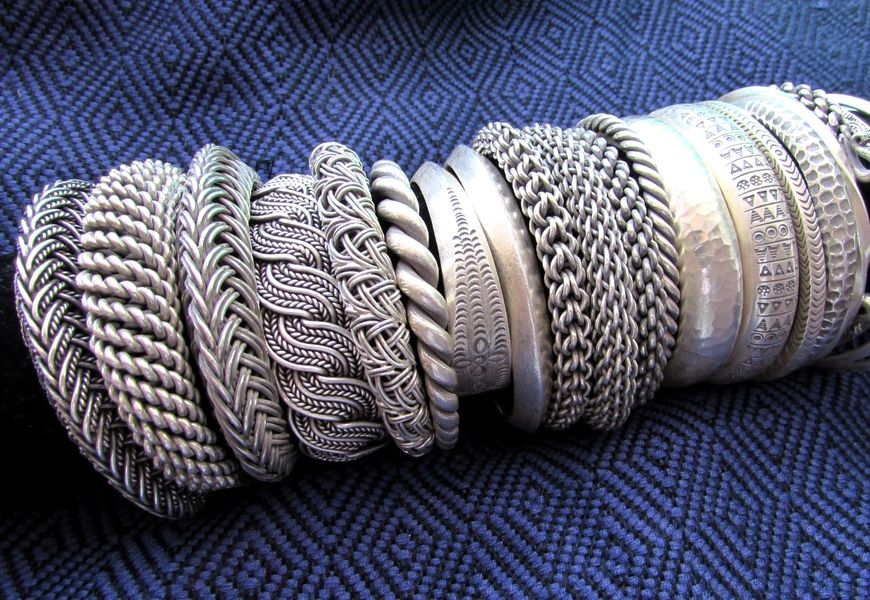
Properties of silver as a precious metal. Evaluation system of silver purity in Russia
Silver belongs to the 5th period of the periodic table of Mendeleev (number 47). It is denoted by the letters Ag. The name of the metal in Latin is Agrentum. In its pure form, it is distinguished by its white color. In addition, Ag is a soft metal. It is inferior to lead in this parameter, but superior to gold. Other properties:
- high plasticity;
- the highest reflection coefficient - close to 100%, which makes silver the best in the production of mirrors, other surfaces with reflectivity;
- The highest degree of thermal conductivity - Ag surpasses all other metals in this parameter;
- conductivity limit value.
Pure Ag is superior to other metals in many ways, but in the manufacture of jewelry and other products they are unimportant, in this case plays a role wear resistance, hardness, which provides additives. In Russia, the metric system is used to control the composition of the precious metal.
Carat
More often used in Europe, the United States, and Canada. Gradually the metric system was introduced in some states (e.g., England), so double branding is still found on items. Determine the amount of Ag in alloy compositionusing a set value of 24 carats. This is a pure metal sample. Its value decreases as the proportion of Ag decreases.
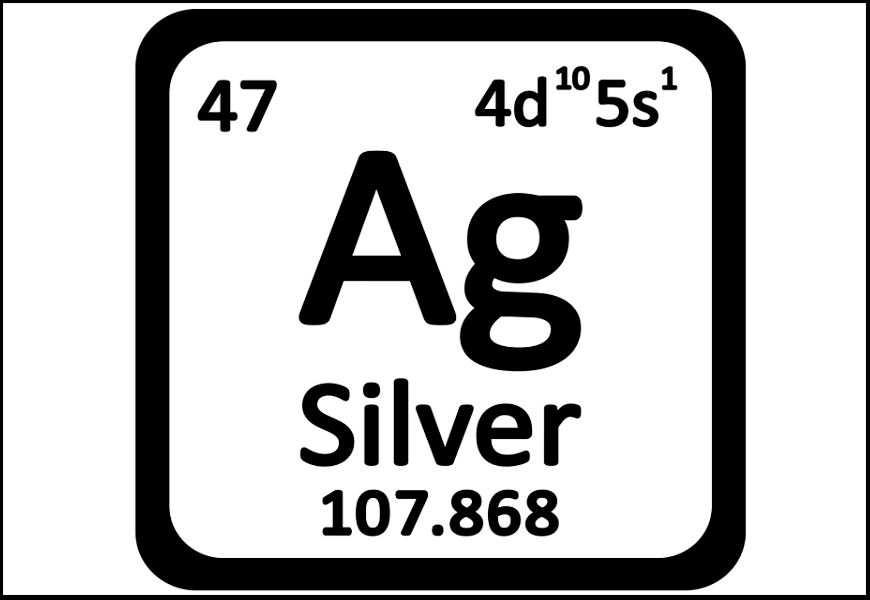
Metric
The determining criterion for calculations is the amount of pure silver in 1 gram of jewelry alloy. The principle of weight parts is also used. The result in both cases is the same. This makes it quite easy to determine how much Ag is in the metal that was used to produce a particular piece. For example, the designation of the best silver assay (925) is deciphered as follows: 1,000 weight parts contain 925 fractions of the precious metal.
This system began to be used in the last century - in the Soviet Union (1927). It is still in use today.
In tsarist Russia before the revolution a different one was used, the spelt system. The metric system is used today in Sweden, the Netherlands, Lithuania, Germany, Great Britain, and many other countries.
Sample Ratio
Modern systems (carat, metric) are interchangeable. It is possible to determine the amount of Ag in the alloy and convert the obtained value to one of them. This is due to the fact that the values of fractions of the metric system at the stage of its development were established taking into account the carat system (recalculation was performed).
The most popular types of silver samples, the ratio of metric and carat values:
| Metric | Carat |
|---|---|
| 999 | 24 |
| 960 | 23 |
| 925 | 22 |
| 875 | 21 |
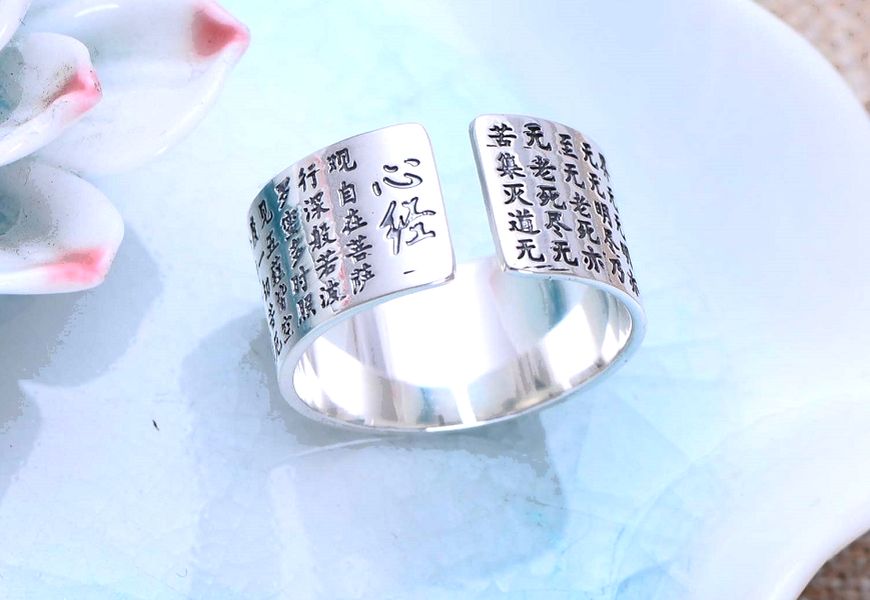
Characteristic properties of the main silver samples
There are many types of stamps, and their values range from 600-999. They correspond to the amount of pure silver, the assay does not determine the proportion of impurities, but it is possible to calculate it yourself. For example, a 925 piece contains 925 weight parts of Ag, as well as 75 weight parts of ligature. Copper, nickel, cadmium, iron and antimony are used as additives. But most often silver is combined with Cu. Each silver grade has its own characteristics:
- 800: contains a fairly high proportion of precious metal (80%), the rest are impurities, the alloy is rarely used in Russia, its main area of application - the production of souvenirs, cutlery and crockery used in everyday life (containers for spices, drinks), much more often it is found in Germany, but the metal samples 800 is considered low-grade, but still 800 is the minimum acceptable fraction of Ag;
- 830: the quality of the alloy is slightly higher than the previously considered variant, the proportion of Ag is 83%, but still such a metal is not common, it is usually used for the production of cutlery, souvenirs;
- 875: such a stamp is found on old silverware, for example, in the USSR, the hallmark was the gold standard in the manufacture of silverware - 84 (marking, according to the ash system), today such products are bought in antique stores, hallmark is found only on antique objects;
- 925: This type is the most frequently hallmarked silver items, but they are more expensive, but at a good account with consumers because of the quality (containing 925 parts by weight of Ag), this variety is considered the most suitable for the production of jewelry, it is put on a par with the alloy 875, but the latter is hardly ever used;
- 960: Metal more valuable, is considered the best because of its high content of Ag (96%), but the alloy has a significant drawback - increased softness, on the one hand, it allows you to give any shape to the product, on the other hand, the finished jewelry easily deformed, so the silver 960 is used in the manufacture of rings, bracelets, chains, but as additional elements;
- 999When deciphering the numerical value of the hallmark this 1% is usually not put, the alloy is usually considered pure, and the minimal amount of additives is written off as natural impurities, but this hallmark on silver indicates that the metal can not be used for manufacturing products, it is used only for the manufacture of ingots.
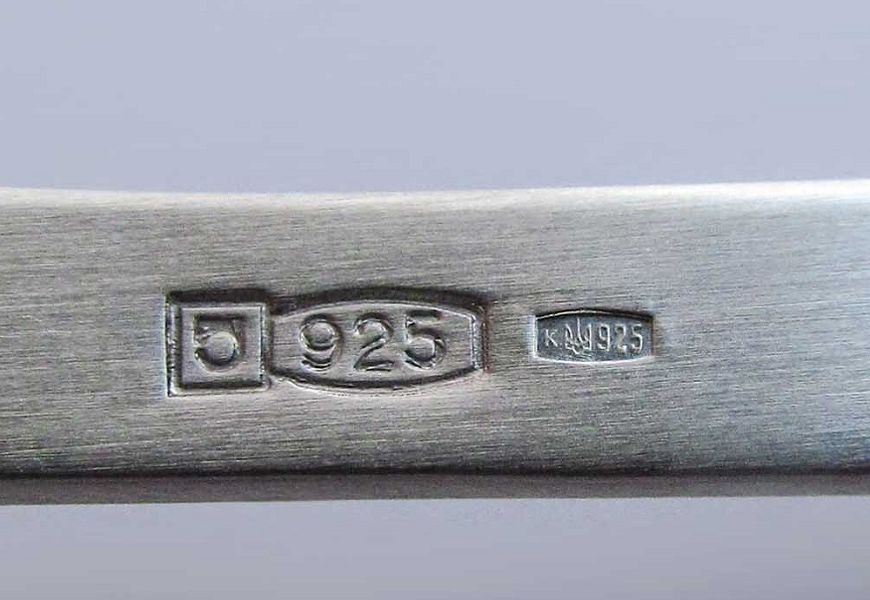
Summary table: what are the samples of silver, their % composition, the scope of application
There are a large number of stamps that are used to mark the silverware, some are no longer in use, and others, on the contrary, are used more often than others, because they are better in composition and properties. To determine which variant is more suitable, it is possible to make a comparison. The most common silver assay in the table:
| Sample | Composition - Ag fraction, % | Area of application |
|---|---|---|
| 720 | 72 | Cheap jewelry made of low-grade alloy, the main difference is its yellowish tint. |
| 750 | 75 | The metal is low-grade, but contains more Ag than alloy 720, and therefore its application area is somewhat wider. In spite of the fact that it is one of the last in the ranking of silver-based materials, it is used for the production of cutlery, crockery and tableware. |
| 800 | 80 | They make kitchen utensils |
| 830 | 83 | The field of application is the same as for other low-grade alloys: production of crockery, cutlery |
| 925 | 92,5 | Used for jewelry, structural elements, coatings, coins, commemorative signs (e.g., produce a goblet) |
| 960 | 96 | Create jewelry, accessories, decorative elements, but because of the softness of the metal can not be used to produce elements in areas of increased responsibility (where significant stress) |
| 999 | 99,9 | Bank metal (bars, coins) |
In Russia, are not popular products of alloy 600, but this metal is found in the European countries, but the minimum acceptable version of the silver hallmark - 800.
Elements of silver marking on jewelry. Control of assaying. Branding
According to Russian law, items containing 80% Ag or more are subject to piercing. Because of the softness, the only possible option for application is laser engraving. Having understood what silver assays there are, it is necessary to understand how the stigma looks to distinguish from fakes. The main elements of the marking:
- sign symbolizing the state ID;
- The assay itself, which determines the amount of precious metal;
- the cipher of the inspection, under the control of which the assaying was carried out, contains a letter (each of the 18 such organizations has its own sign, so it was possible to recognize the assaying district).
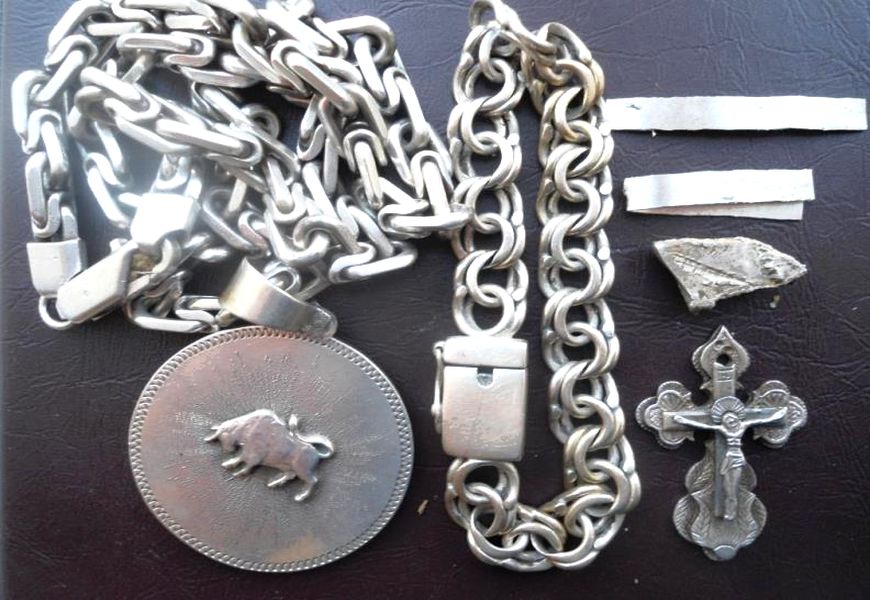
All silver assays indicate that the metal is classified as precious, containing real Ag. But at different times in Russia certain additional symbols were used:
- Nineteenth century: the profile of a woman, first placed facing left, then right, but always in the middle (between the symbol of the assay district and the metal assay);
- last century - profile of a man (worker) with a hammer;
- mid-20th century: star, "hammer and sickle" symbols;
- The woman's profile in the kokoshnika.
At various times, other conventions were used in other countries:
- The lion (UK) is the Assay Office of London;
- crown (Finland);
- letter designation (Hungary) - "N";
- SUTF (Tallinn until 195);
- crab - France.
The cost of 1 gram of pure silver: how the price is fixed
The price changes on a daily basis. However, one of the values is fixed, and it happens twice a day. The price of silver on the Russian market depends not only on the Central Bank of Russia. The price established by the main international exchange in London also has an influence. The value of the fixing is the main reference point for market participants.
Formula and results of the calculation of the value of the corresponding sample
You can find out the price of silver without resorting to reputable sources. To do this, you will need the value of 1 g of pure metal. This number is multiplied by the value corresponding to the content of Ag in the alloy, examples for different samples:
- 800: 65.56*0.8=52.45 rubles;
- 830: 65.56*0.83=54.42 rubles;
- 875: 65.56*0.875=57.34 rubles;
- 925: 65.56*0.925=60.65 rubles;
- 960: 65.56*0.96=62.94 rubles.
The cost at Sberbank and others may differ from the Central Bank rate. This is due not only to the composition of the metal, but also to the policies of the organization.
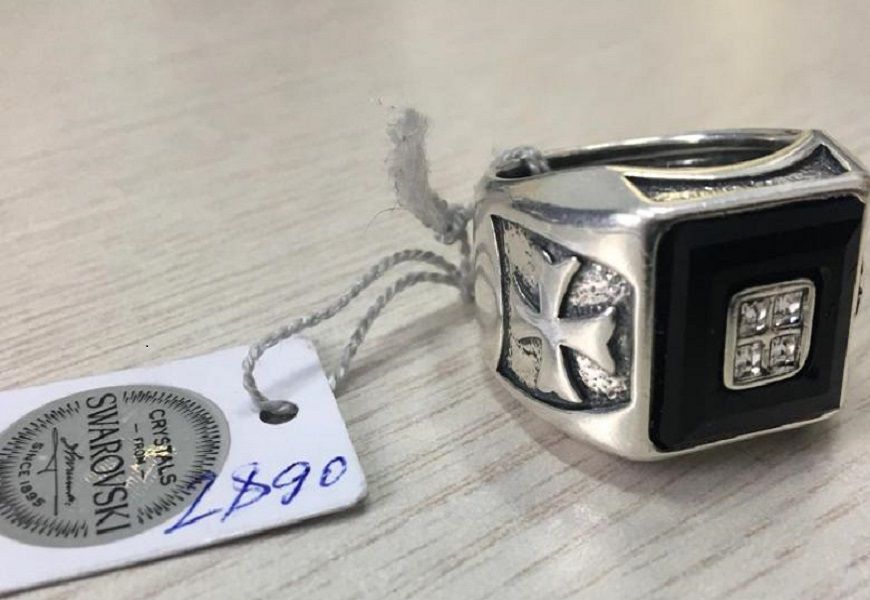
Factors influencing the consumer value
The cost of sterling silver metal and alloys based on it depends on several factors. The determining factor is:
- the cost of raw materials;
- exchange rate;
- the value of currency and precious metal of the central banks of other countries;
- the total amount of raw materials not only in the Russian Federation, but also worldwide;
- the degree of demand for the metal.
According to experts, the development of existing fields will be completed in 2 decades, then there will be a surge in the price of Ag.
Table: Other rare samples of silver, applications
At different times and for different purposes, alloys with non-standard parameters are also used. Ag content may be minimal or sufficient, but for various reasons such materials are used frequently. If you are wondering what silver assays fall into this category, you should study the table:
categories, you should study the table:
| Sample | Composition, % | Area of application |
|---|---|---|
| 325 | 32,5 | Cheap jewelry, often silver is not even used |
| 500 | 50 | Coinage has been made for a long time |
| 525 | 52,5 | Silver is gilded to enhance its value |
| 585 | 58,5 | |
| 625 | 62,5 | |
| 800 | 80 | A popular brand in Germany |
| 825 | - | Used by crooks, there is no such assay |
| 835 | 83,5 | Applicable in Germany |
| 900 | 90 | |
| 916 | 91,6 | Utensils, articles used to perform ritual actions |

Methods for determining counterfeit silver
You should not always trust the engraving on the piece. All silver hallmarks can be tested for authenticity, but the result depends on the composition of the metal. It is possible to understand what this or that sign means, it is necessary to learn more about the application of verification techniques:
- needle: not the most reliable method, it is enough to make 1-2 scratches on the metal, if the color of the alloy is different in depth (yellow, red), it is not silver, but cheaters can also use metals of similar hue;
- nitric acid: when nitric acid is applied to pre-made scratches with a needle, a black tint can be seen if there are no additives (the metal is labeled breakdown of 999), when there is a ligature but not enough (925), the color should be white, a green hue may mean that the metal contains too much copper;
- Lapis pencil: usually put a dot or a strip, a fake will darken when it is applied;
- sulfur ointment: in contact with sulfur, silver darkens, which means that if the product is colored black, it is precious, the fake alloy will remain unchanged or turn green;
- Iodine: the ligature will behave differently when applied (the zinc will turn blue), and the fake alloy will not change its appearance;
- hot water: the easiest way to test silver at home, just dip the item in boiling water for 15 seconds, then take it out, the real metal will be very hot, fake - barely warm, which is due to the high thermal conductivity of Ag;
- magnet: bringing a magnet 10-15 mm closer to the item allows you to understand whether the entire item is made properly - made of silver, this applies mainly to chains, sometimes manufacturers replace some of the links with simple materials, so it is recommended to check the entire length of the product, assessing also the external quality of the weave, with Ag will not react to the magnet.
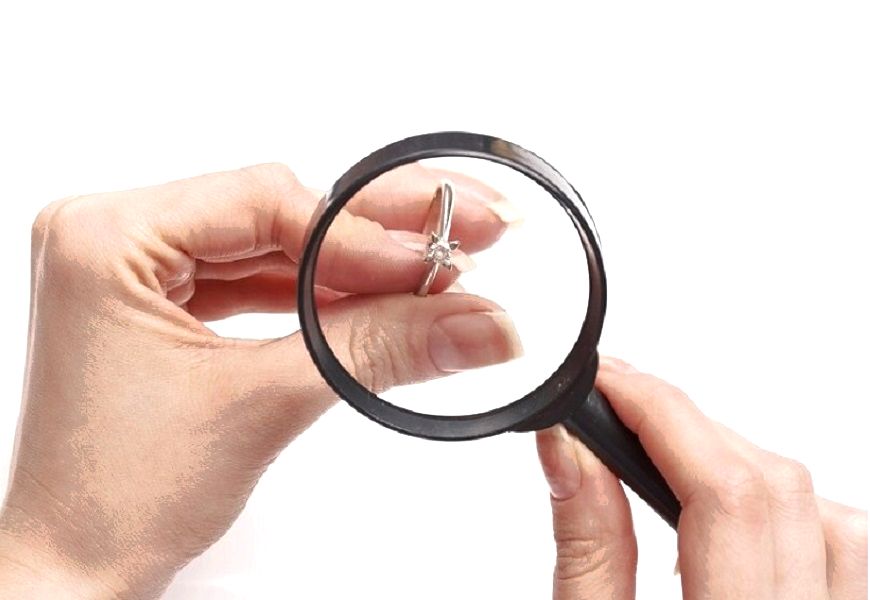
Branding on the counterfeit
Fraudsters use real stamps on silverware - is transferred using the fusion method. The new sample is attached using brazing technology to a non-precious metal object. But on closer inspection, you can see traces of the transfer.
Scammers often do not take into account the peculiarities of the branding of jewelry of that time. To do this, you need to study the catalog in antique stores, find the right period, check the location and type of assay.
Labeling of imported silver
When shipping products that have been manufactured abroad contain other stigmaIt is obligatory to re-stamp - on the territory of the Russian Federation. And the assay is placed in accordance with the requirements of the Assay Chamber, the law of Russia. Only after that you can sell the ring, bracelet or other jewelry.
How to Determine the Taste of a Product by Yourself
If the item has no identification marks (this happens after repairs, if it is an antique, or when importing foreign jewelry), you can determine with your own hands how much silver the item contains. A simple method is based on the assay testing reagent ("Chrompic"). Instructions:
- Making a scratch.
- The substance is applied.
- Wait 5-10 minutes. If a red color appears, most likely the product is of the highest grade, the shade of red is darker - 925 proof, brown - product 800, green - less than 800.
How to choose the right silverware
Pay attention to the color, weight: Ag is a rather heavy metal with a white color. The more copper, the closer the shade is to red. In addition, the products 925 proof are less responsive to a magnet than jewelry with less Ag. Silver-plated jewelry will be marked "MET".
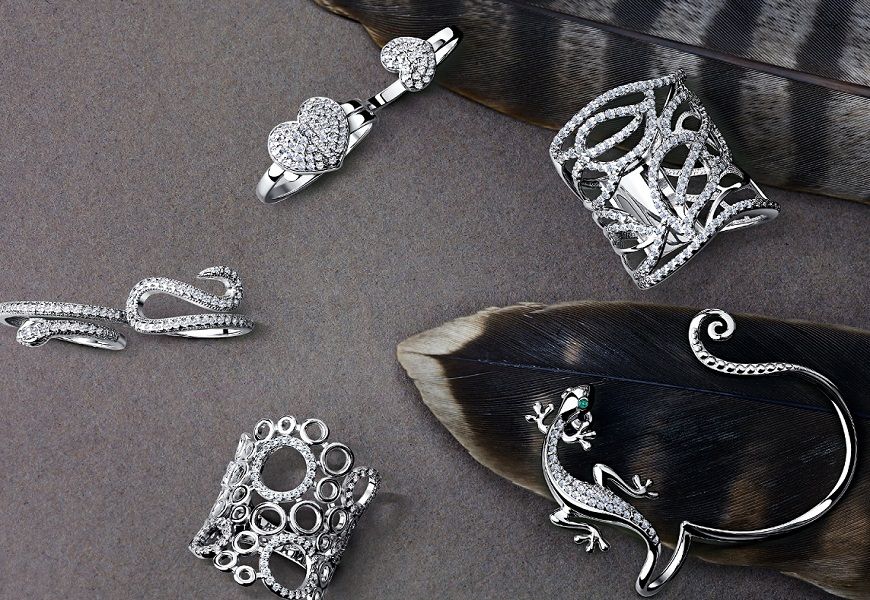
Question and answer section
What is the best and most expensive type of silver?
Sterling silver, how do I know what the proof is?
How do I determine the silver grade at home?
What is the highest precious metal assay?
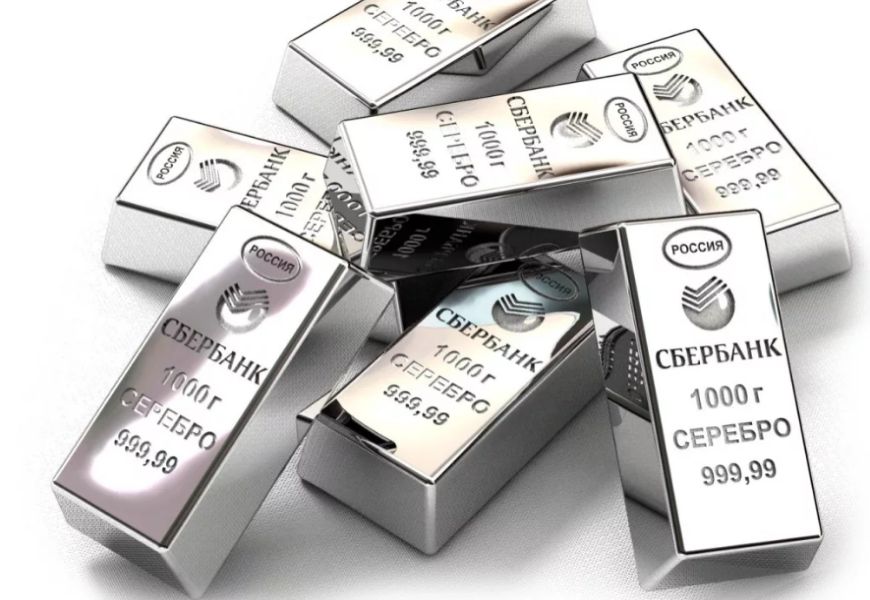
Antique samples of silver, what are they?
- Fabergé had a double-headed eagle;
- The Grachev masters applied their surname and coat of arms - a two-headed eagle;
- Spools - samples popular in the last century, this group includes variants: 84, 88, 92, 96.
Imitation Metals
In order to reduce the cost of the products, as well as to make them more similar to silver, materials containing strong components, but without precious metals, were used:
- Melchior (MN) - most often used for the production of copper and nickel, less often added zinc, manganese or iron, this material is more like Ag, due to the color - also white, but melchior more solid;
- nesilver (MNZ) - the metal was called the new silver, contains copper, nickel and zinc, this combination results in an alloy that does not differ in appearance and properties from melchior, but its production is cheaper;
- aluminum (AL) is a foundry aluminum alloy that contains various metals;
- Stainless steel (NERV) is another analogue of silver, but differs in appearance from the precious metal.
Video: Silver Sample. How to test silver at home
Jeweler's comment

If you misidentify the composition of the metal, nothing bad can happen. But the person who was going to sell it may be disappointed when it turns out that under the guise of silver was not a precious alloy, but a fake.
Reviews
I work in a design bureau, so making jewelry is close to me. I have recently learned that nowadays not many people bother with the question of the originality of the material, its beauty. Fraudsters can simply put a hallmark on any item that looks like silver. I am not fooled in this way, but there are many people who get caught.


At home, almost all the jewelry is silver - alloy 925. They wear fine, but they get darker. But I can tell you that pieces that have lower Ag content are not much worse. I would not have noticed if I did not know the composition. They differ in price, perhaps, but that's all.
When I brought my grandmother's jewelry from abroad after her death, I had to deal with it for a long time to sell it. You have to brand them, otherwise you won't be able to sell the pieces to worthwhile stores.

